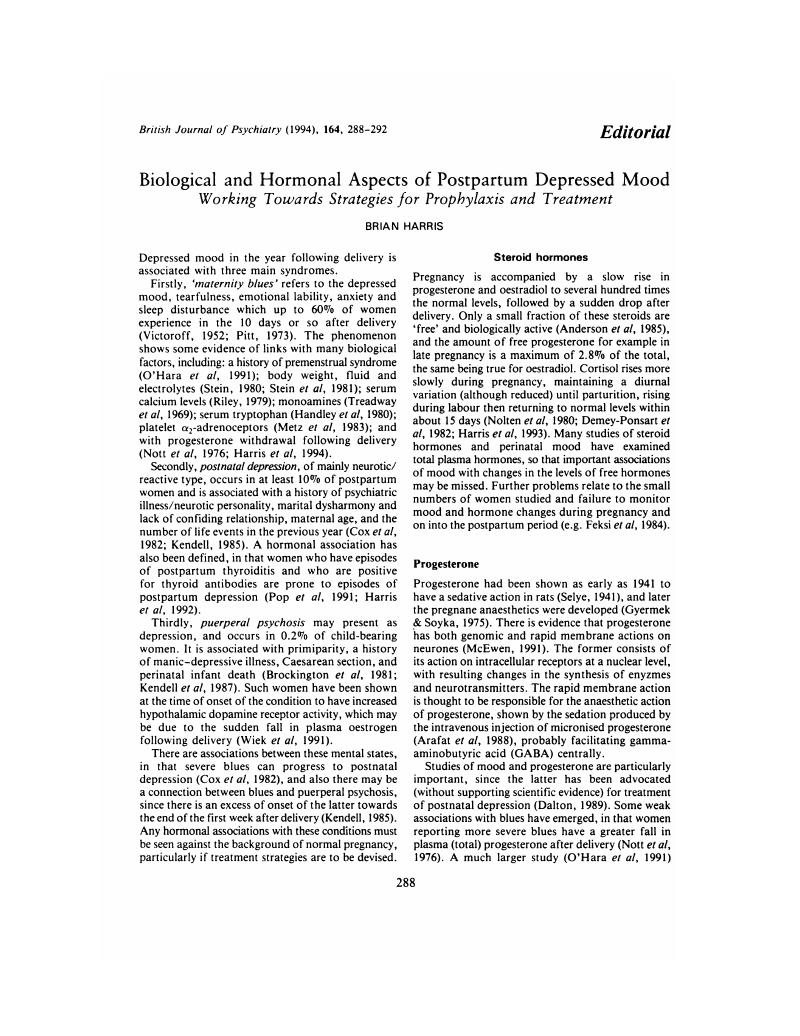Crossref Citations
This article has been cited by the following publications. This list is generated based on data provided by Crossref.
Cooper, Peter J.
and
Murray, Lynne
1995.
Course and Recurrence of Postnatal Depression.
British Journal of Psychiatry,
Vol. 166,
Issue. 2,
p.
191.
Zelkowitz, Phyllis
1996.
Childbearing and Women's Mental Health.
Transcultural Psychiatry,
Vol. 33,
Issue. 4,
p.
391.
Sandyk, Reuven
1996.
Estrogen's Impact on Cognitive Functions in Multiple Sclerosis.
International Journal of Neuroscience,
Vol. 86,
Issue. 1-2,
p.
23.
Fossey, L.
Papiernik, E.
and
Bydlowski, M.
1997.
Postpartum blues: a clinical syndrome and predictor of postnatal depression?.
Journal of Psychosomatic Obstetrics & Gynecology,
Vol. 18,
Issue. 1,
p.
17.
Cavalcante, Simone Neno
1997.
Notas sobre o fenômeno depressão a partir de uma perspectiva analítico-comportamental.
Psicologia: Ciência e Profissão,
Vol. 17,
Issue. 2,
p.
2.
Whiffen, Valerie E.
and
Johnson, Susan M.
1998.
An attachment theory framework for the treatment of childbearing depression..
Clinical Psychology: Science and Practice,
Vol. 5,
Issue. 4,
p.
478.
Hagen, Edward H
1999.
The Functions of Postpartum Depression.
Evolution and Human Behavior,
Vol. 20,
Issue. 5,
p.
325.
Glasser, S.
Barell, V.
Boyko, V.
Ziv, A.
Lusky, A.
Shoham, A.
and
Hart, S.
2000.
Postpartum depression in an Israeli cohort: Demographic, psychosocial and medical risk if actors.
Journal of Psychosomatic Obstetrics & Gynecology,
Vol. 21,
Issue. 2,
p.
99.
Buckwalter, J.Galen
Buckwalter, Deborah K.
Bluestein, Brendon W.
and
Stanczyk, Frank Z.
2001.
The Maternal Brain.
Vol. 133,
Issue. ,
p.
303.
Josefsson, Ann
Angelsiöö, Lisbeth
Berg, Göran
Ekström, Carl-Magnus
Gunnervik, Christina
Nordin, Conny
and
Sydsjö, Gunilla
2002.
Obstetric, Somatic, and Demographic Risk Factors for Postpartum Depressive Symptoms.
Obstetrics & Gynecology,
Vol. 99,
Issue. 2,
p.
223.
Rubinow, David R.
and
Schmidt, Peter J.
2002.
Gonadal steroids, brain, and behavior: role of context.
Dialogues in Clinical Neuroscience,
Vol. 4,
Issue. 2,
p.
123.
Payne, J. L.
2003.
The role of estrogen in mood disorders in women.
International Review of Psychiatry,
Vol. 15,
Issue. 3,
p.
280.
Bloch, Miki
Daly, Robert C
and
Rubinow, David R
2003.
Endocrine factors in the etiology of postpartum depression.
Comprehensive Psychiatry,
Vol. 44,
Issue. 3,
p.
234.
Armstrong, Kylie
and
Edwards, Helen
2004.
The effectiveness of a pram‐walking exercise programme in reducing depressive symptomatology for postnatal women.
International Journal of Nursing Practice,
Vol. 10,
Issue. 4,
p.
177.
2004.
Revision Notes in Psychiatry, Second Edition.
p.
427.
Selkirk, Rosemary
McLaren, Suzanne
Ollerenshaw, Alison
McLachlan, Angus J.
and
Moten, Julie
2006.
The longitudinal effects of midwife‐led postnatal debriefing on the psychological health of mothers.
Journal of Reproductive and Infant Psychology,
Vol. 24,
Issue. 2,
p.
133.
Dayan, J.
2007.
Clinique et épidémiologie des troubles anxieux et dépressifs de la grossesse et du post-partum. Revue et synthèse.
Journal de Gynécologie Obstétrique et Biologie de la Reproduction,
Vol. 36,
Issue. 6,
p.
549.
Milgrom, J.
and
Rolland, A.-C.
2008.
Les dépressions périnatales.
p.
87.
Dayan, J.
and
Baleyte, J.-M.
2008.
Les dépressions périnatales.
p.
21.
Eberhard-Gran, Malin
2009.
Depresjon før og etter fødselen.
Tidsskrift for Den norske legeforening,
Vol. 129,
Issue. 11,
p.
1133.






eLetters
No eLetters have been published for this article.